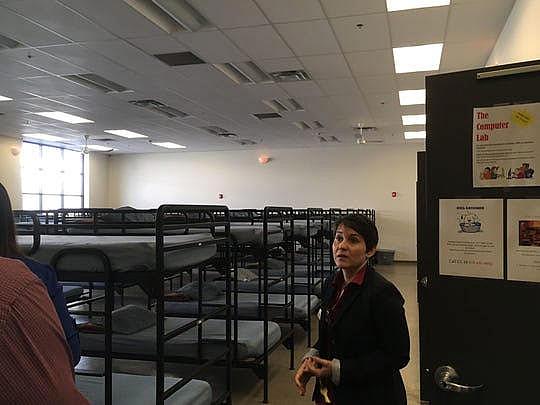You asked, we answered: Why did Roy's Desert Resource Center close in Palm Springs?
This story was produced as part of a larger project led by Nicole Hayden, a participant in the USC Center for Health Journalism's 2019 Data Fellowship.
Other stories in this series include:
The Desert Sun interviewed 200 homeless individuals about health care. Here's what we found
You asked, we answered: How can people help those who are homeless in the Coachella Valley?
You asked, we answered: How is money being spent on homeless services in Riverside County?
Homeless in the Coachella Valley: Join us for a special evening of storytelling, solutions

Photo: Skip Descant/ The Desert Sun
Despite having closed in the summer of 2017, Roy’s Desert Resource Center still comes up in conversations about homelessness in the Coachella Valley.
So, it’s not surprising that when we asked readers to send in questions they had about homelessness in the Coachella Valley, the topic of Roy’s popped up once again.
The third installment of the Coachella Valley homelessness Q&A series addresses the rise and fall of the west valley emergency shelter. To be added to an email list to receive updates about this project and other homeless-related reporting, please email Nicole.Hayden@desertsun.com.
Question: Why did Roy’s Resource Center close without a plan to replace it?
One reader wrote in with concern about the impact the closure had on those who accessed services at Roy’s in Palm Springs.
“To close Roy’s in triple-digit heat in mid-July without having a viable replacement was inhumane,” said Greg Varra, 61, of Palm Springs. Varra said he is particularly passionate about the issue because he has volunteered for Well in the Desert and for the annual Point-in-Time homeless count, as well as attended various homelessness task force meetings.
Answer: The center was costly to run and officials wanted to launch a different kind of homeless services program
The homeless shelter and resource center were operated by Jewish Family Services of San Diego, contracted through the Coachella Valley Association of Governments.
When the shelter closed, Sarah Hopkins, 44, of Desert Hot Springs said the impact rippled through the Palm Springs-area homeless community. Hopkins, who is currently homeless, said she often used Roy’s services when it was open. She went through three 90-day programs at the shelter.
“The community was extremely impacted,” she said, while waiting for a bus along Indian Canyon Drive in Palm Springs in early March. “There were no longer shelter beds in Palm Springs for people to go to if they needed immediate help or were kicked out of sober living or something. The counselors we had, they were gone, too.”
Roy’s Desert Resource Center opened at the end of 2009 after CVAG pitched the idea to the nine valley cities. According to prior Desert Sun reporting, funding problems surfaced almost immediately. Cities that had agreed to pay for Roy’s either backed out or paid less than promised. Without the expected funding, the shelter had to decrease the amount of services it could offer, and often had to keep a portion of its 120 beds empty.
Palm Springs, Rancho Mirage and Palm Desert made payments of $103,000 annually between 2011 and 2016. Cathedral City paid half of that. Indian Wells stopped paying in 2014. La Quinta did not contribute. Coachella and Desert Hot Springs paid $40,000 and $10,000. Indio paid through an agreement with Riverside County, which has contributed most of the funding including $850,000 during the final two fiscal years of its existence. Of that total, $103,000 was from Indio's annual contribution.
As the Roy’s contract was about to expire in the summer of 2017, Jewish Family Services indicated they would not seek an extension, said Riverside County Board of Supervisors Public Policy Advisor Greg Rodriguez, 4th District.
“At the same time, (Riverside) County was looking for a location to build much-needed mental health beds. The county is transitioning the building into a mental health facility and CVAG worked with its partners, including the county, to develop the program now known as CV Housing First,” Rodriguez said.
Rodriguez said the mental health facility is slated to open in 15 months. The 110-bed facility will provide in-patient behavioral health services with on-site nursing staff. It is being funded through Riverside County’s behavioral health department, which provides homeless-related services to for the county.
The CV Housing First program, which focuses on long-term housing for people experiencing homelessness, replaced the emergency shelter, which provided temporary beds. The change happened as the conversation about how best to help individuals who are experiencing homelessness changed. For the past several years, funding and research have leaned toward rapid re-housing programs rather than emergency services. The Coachella Valley largely has been split on this discussion.
The Coachella Valley Rescue Mission and Martha's Village and Kitchen are the valley's largest shelters and are both located in Indio.
CVRM is continually at-capacity and has seen the demand for beds increase. Previously, Tom Cox, CVRM program director, has partially attributed this to the closure of Roy’s. Those in the west valley who find themselves in need of emergency shelter must find a way to make the 45-minute drive to one of the two east valley shelters.
Cox has previously stated that both long-term housing and emergency shelter resources are needed – arguing it shouldn’t be one or the other – because every individual’s needs are different.
Desert Sun reporter Nicole Hayden covers health and healthcare in the Coachella Valley. She can be reached at Nicole.Hayden@desertsun.com or (760) 778-4623. Follow her on Twitter @Nicole_A_Hayden.
[This story was originally published by the Desert Sun.]

